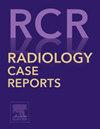主动脉髂钙化阻碍心脏介入:血管内碎石1例
Q4 Medicine
引用次数: 0
摘要
主动脉钙化与主要不良心血管事件的风险增加有关,虽然有关于其治疗的病例报道,但目前尚无专家共识或指南。一名81岁男性患者因反复跌倒,被诊断为严重症状性主动脉狭窄(AS)和冠状动脉疾病(CAD),需要高风险经皮冠状动脉介入治疗(PCI)和经导管主动脉瓣置换术(TAVR)。严重的主动脉髂动脉钙化使临床决策复杂化,对大口径鞘置入提出了挑战。在心脏小组复查后,使用双侧7×60毫米球囊进行冲击波血管内碎石术(IVL),在低膨胀压力下传递声压波,选择性地破坏内膜和内侧钙。改善血管顺应性有助于impella辅助PCI和分期TAVR。本病例表明,当其他方法有限时,IVL可能是主动脉钙化的可行选择。它熟悉的气球设计和低压膨胀增强了它的吸引力。虽然程序性血管风险确实存在,但它们仍然很低,可以通过适当的设备尺寸和技术将其降至最低。本文章由计算机程序翻译,如有差异,请以英文原文为准。
Aortoiliac calcification hindering cardiac interventions: A case for intravascular lithotripsy
Aortic calcification is associated with an increased risk of major adverse cardiovascular events, and while cases have been reported for its management, no expert consensus or guidelines currently exist. An 81-year-old male presented with recurrent falls and was diagnosed with severe symptomatic aortic stenosis (AS) and coronary artery disease (CAD) requiring high-risk percutaneous coronary intervention (PCI) and transcatheter aortic valve replacement (TAVR). Severe aortoiliac calcifications complicated clinical decision-making, posing a challenge to large-bore sheath placement. After heart-team review, shockwave intravascular lithotripsy (IVL) with bilateral 7×60 mm balloons was utilized to deliver sonic pressure waves at low inflation pressures to selectively fracture intimal and medial calcium. Improved vessel compliance facilitated Impella-assisted PCI and staged TAVR. This case demonstrates that IVL may be a viable option for aortic calcification when alternative approaches are limited. Its familiar balloon-based design and low-pressure inflation enhance its appeal. While procedural vascular risks do exist, they remain low and can be minimized with proper device sizing and technique.
求助全文
通过发布文献求助,成功后即可免费获取论文全文。
去求助
来源期刊

Radiology Case Reports
Medicine-Radiology, Nuclear Medicine and Imaging
CiteScore
1.10
自引率
0.00%
发文量
1074
审稿时长
30 days
期刊介绍:
The content of this journal is exclusively case reports that feature diagnostic imaging. Categories in which case reports can be placed include the musculoskeletal system, spine, central nervous system, head and neck, cardiovascular, chest, gastrointestinal, genitourinary, multisystem, pediatric, emergency, women''s imaging, oncologic, normal variants, medical devices, foreign bodies, interventional radiology, nuclear medicine, molecular imaging, ultrasonography, imaging artifacts, forensic, anthropological, and medical-legal. Articles must be well-documented and include a review of the appropriate literature.
 求助内容:
求助内容: 应助结果提醒方式:
应助结果提醒方式:


